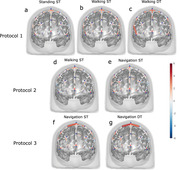- Record: found
- Abstract: found
- Article: found
Using functional near‐infrared spectroscopy to measure prefrontal cortex activity during dual‐task walking and navigated walking: A feasibility study

Read this article at
Abstract
Introduction
While functional near‐infrared spectroscopy (fNIRS) can provide insight into motor‐cognitive deficits during ecologically valid gait conditions, the feasibility of using fNIRS during complex walking remains unknown. We tested the process and scientific feasibility of using an fNIRS device to measure cortical activity during complex walking tasks consisting of straight walking and navigated walking under single and dual‐task (DT) conditions.
Methods
Nineteen healthy people from 18 to 64 years (mean age: 45.7 years) participated in this study which consisted of three complex walking protocols: (i) straight walking, DT walking (walking while performing an auditory Stroop task) and single‐task auditory Stroop, (ii) straight and navigated walking, and (iii) navigated walking and navigated DT walking. A rest condition (standing still) was also included in each protocol. Process feasibility outcomes included evaluation of the test procedures and participant experience during and after each protocol. Scientific feasibility outcomes included signal quality measures, and the ability to measure changes in concentration of deoxygenated and oxygenated hemoglobin in the prefrontal cortex.
Results
All participants were able to complete the three protocols with most agreeing that the equipment was comfortable (57.9%) and that the testing duration was adequate (73.7%). Most participants did not feel tired (94.7%) with some experiencing pain (42.1%) during the protocols. The signal qualities were high for each protocol. Compared to the rest condition, there was an increase in oxygenated hemoglobin in the prefrontal cortex when performing dual‐task walking and navigation.
Conclusion
We showed that our experimental setup was feasible for assessing activity in the prefrontal cortex with fNIRS during complex walking. The experimental setup was deemed acceptable and practicable. Signal quality was good during complex walking conditions and findings suggest that the different tasks elicit a differential brain activity, supporting scientific feasibility.
Abstract
Related collections
Most cited references38
- Record: found
- Abstract: found
- Article: not found
The hospital anxiety and depression scale.

- Record: found
- Abstract: found
- Article: found
